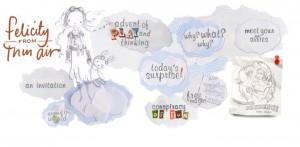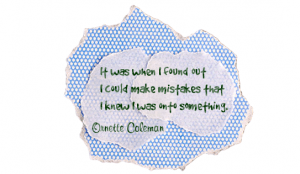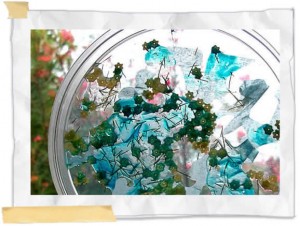Tonight’s #edchat topic on Twitter was: Can we agree on a common goal of education?
My response:

The goal of education is to provide the conditions for learning. I think that it is a broad enough goal for everything else to fall into place. I engaged in some discussion about how current conditions keep us from that goal. While I agree to some extent, I think that excuses are an easy way to stay where we are. We can create conditions for learning without administrative support, without funding for technology, without the best conditions. How do I know this? Because I had teachers who did it for me. They used what they had, within the system they were in, to provide us with the conditions for learning. And guess what? We learned.
Now, this is not to say that the goal wouldn’t be more attainable if we weren’t mired in a system that is run by testing and policies. It is better to have ubiquitous use of technology and freedom within our classrooms. I believe that those things will come. But right now we are working within this system. For now we can create conditions of learning for our students using what we have available to us. Is it ideal? No. Is it possible? Of course. All it takes is some creativity.
I want to be clear, creating conditions for learning does not mean that every classroom looks the same. It means that the conditions created match that unique student population. The conditions that I learn best in may look different from the conditions that you learn best in. This means that teachers have to know and understand the needs of their students. The conditions of learning may change every year, every month, every day, and even every hour. We are human, our needs are constantly changing.
Someone mentioned during the #edchat, that it would be great to see how students answered this question. I actually know how my students answered this question, because I asked my 3rd-5th grade students to answer it last year. My students answered something like this: the goal of education is to get good grades and pass tests so you can go to college. Not the answer most of us would like to hear but there it is. Did we really expect differently? This is what our school system breaths. This is the current goal of education, to move students through so that they graduate and go to college.
Being the computer teacher has some major advantages, one of which is that there is no curriculum to follow. I write my own curriculum every year. I have a scope and sequence of skills that I want my students to gain and I use a different path to get there each and every year. I didn’t originally intend for this to be a year-long project, but that is what it became because it made my students think differently, creatively. It made them question, discuss, and debate. It was brilliant.
We had just finished learning the Internet safety rules, and were practicing netiquette. I wanted my students to have an authentic place to practice their newly acquired skills so I sent them on their way to write their first blog entry. The topic: Write about your dream school. If you could make a school look like whatever you wanted it to, what would it look like? How would learning happen there?
After the students had a chance to blog their dreams, I asked them to pick their favorite idea and add it to our class Wallwisher. I cannot tell you how disappointed I was with the answers. They were the most unimaginative answers I had ever seen. I’m talking zero in the creativity department. It was as if they were writing what they thought I wanted to hear. Then it hit me, they were writing what they thought I wanted to hear. Isn’t that what their education has primed them for? Guess what the teacher is thinking. There is only one right answer and then we move on to the next thing.
Not willing to let the project go, the next week I sat all of my students down and asked them again what their dream schools would look like. They hadn’t gotten more creative with their answers in the week they had to think about them. The look of utter confusion on their faces was obvious. They couldn’t figure out what the right answer was, the one that I wanted to hear that would move us on to the next topic. I showed my students pictures of the inside of Googleplex and Pixar. You have never heard so many “oohs” and “awwws”. By the end of the slide show, every kid was declaring that they were going to work at Google or Pixar some day. I asked them why they would want to work there?
“Because it is SO cool!”
“Did you see the Lego room?”
“They get to play all day!”
“It is so colorful.”
“It looks like a playground.”
“They have a chef that cooks lunch for them.”
We talked about why Googleplex and Pixar look the way they do and the philosophy that each company has. We talked about what it means to be creative and the things that help us get in that creative element. Then I showed them some pictures of schools, one had a slide in the building, another had students singing and dancing on top of desks, another of students sitting on exercise balls instead of chairs. The common phrase uttered was “they are so lucky!” I also showed them the YouTube video of the piano stairs.
I asked them to go back to their seats and blog about their dream school again. I told them that there was no right answer. The right answer was their answer. The sky was the limit. This time the ideas were infinitely more exciting. Some students still played it safe and stuck to what was possible in the confines of the school system they knew. Others wanted anti-gravity classrooms. There were common threads in every one of my students blog posts: they all wanted flexible learning spaces, they all wanted more hands on/active learning, they wanted school to feel like play, and they all wanted animals to be involved in some fashion.
You can see some of their answers on these Wallwishers:
3rd Grade1
4th Grade1
4th Grade2
5th Grade 1
My students got so excited about this little blogging activity that they continued to post about what their dream schools would look like (even though I hadn’t assigned it). I had students stop by my classroom and tell me another idea they had for a dream school. Then I had students start asking if I would ask the administration to make our school a dream school. I can only imagine how that would go, so instead I expanded the project.
I asked my students to imagine that they actually got the go ahead for their school, and now they had to advertise for it. They had to convince me to send my imaginary children to their imaginary school. They had to make a convincing case for why their school made the best place to learn. Each student made a brochure advertising their school. They highlighted the features of their school, promised amazing things, and sold it! I am telling you, I have never seen such amazing work out of my students! I would have sent my imaginary kids to any one of their schools. Boy did they sell it! The brochures looked amazing. I brought them into the teacher’s lounge to pass around. The teachers couldn’t believe what their students were capable of. It was great! A few of the kids brought the brochure they created to the administration to show off.
The kids hadn’t had enough, they wanted to explore the idea further. I had them create commercials for their school. I showed them the Kaplan University commercials and told them they could be inspiring like Kaplan, factual, funny, or any combination of the three. They set to work using their method of choice. Some used Keynote, others recorded in Photobooth and edited in iMovie, some used Xtranormal, some GoAnimate, and others used the ZimmerTwins. The commercials were fabulous.
Toward the end of the year I had the kids create websites for their imaginary dream schools. They used Weebly to create the websites. I cannot tell you how impressed I was with the level of creativity, innovation, and fun that showed up on those sites. The kids were convincing, but more than that, they were right. They may have started with every student having a laptop, pony, and anti-gravity rooms, but where they ended was with rich learning experiences. At the core what our students want is an opportunity to discover, play, and experiment with their learning. They want to feel safe. They want to be active. I wish I could share the finished sites and commercials with you, I can’t because they contain pictures of students and other identifying information.
I learned a lot from my students as a result of the project, at the heart of it is this: provide conditions where we can learn.















